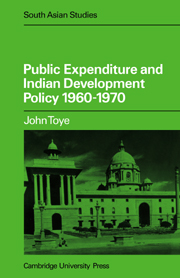Book contents
- Frontmatter
- Contents
- List of Tables
- Preface
- List of Abbreviations
- Introduction
- PART ONE GENERAL
- 1 Public expenditure and state accumulation in theory
- 2 Indian nationalism and the state accumulation policy
- 3 The interpretation of Indian public expenditure statistics
- PART TWO EMPIRICAL EVIDENCE
- PART THREE CONCLUSIONS
- APPENDICES
- List of works cited
- Index
2 - Indian nationalism and the state accumulation policy
from PART ONE - GENERAL
Published online by Cambridge University Press: 09 January 2010
- Frontmatter
- Contents
- List of Tables
- Preface
- List of Abbreviations
- Introduction
- PART ONE GENERAL
- 1 Public expenditure and state accumulation in theory
- 2 Indian nationalism and the state accumulation policy
- 3 The interpretation of Indian public expenditure statistics
- PART TWO EMPIRICAL EVIDENCE
- PART THREE CONCLUSIONS
- APPENDICES
- List of works cited
- Index
Summary
MIMETIC NATIONALISM
Having examined the notions of ‘public expenditure control’ and ‘state accumulation’ in the abstract, they must now be located in the concrete context to which our empirical evidence relates. This context is the political economy of India in the 1960s. The theme that underlies our characterization of the Indian political economy is that class analysis must be supplemented by an understanding of the phenomenon of nationalism, if over-simple conclusions are to be avoided.
One fundamental error which continues to plague class analyses of India must be firmly rejected right at the start. That error is the view that the state is merely the instrument of a single dominant class. Rejection should be based on two separate grounds. First, in many less developed countries, and certainly in India, the empirical analysis of class shows that there is no single dominant class. Rather, several distinct classes with conflicting economic interests are co-dominant. Even with the most aggregative class analysis of India, the monopoly bourgeoisie, landlords, rich peasants and other groups like the bureaucracy and the armed forces (which are not strictly classes on Marxist criteria) would have to be separately distinguished as co-dominant classes and groups. This alliance of social codominance is uneasy, and short-run and even medium-term class analysis for India consists of charting the shifts in status, power and influence among the parties to this alliance.
- Type
- Chapter
- Information
- Public Expenditure and Indian Development Policy 1960–70 , pp. 21 - 48Publisher: Cambridge University PressPrint publication year: 1981



